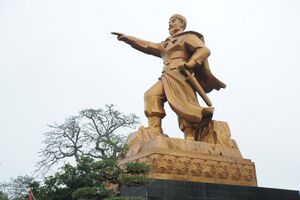Âu Lạc Rebellion
| Âu Lạc Rebellion | |||||||
|---|---|---|---|---|---|---|---|
 Statue of Hoạn Quốc Tổ in Kontin | |||||||
| |||||||
| Belligerents | |||||||
|
Âu Lạc Alliance:
|
| ||||||
| Commanders and leaders | |||||||
|
| ||||||
The Âu Lạc Rebellion (Quenminese: Khởi nghĩa Âu Lạc) was a massive insurrection waged by the Âu Lạc Alliance from 1080 to 1087. It was directed against the Makedonian Empire and its viceroy Seleucus with the mutual goal of establishing independence of the nations comprising the Alliance, Đại Quến, Nagarcam, the Paphan Kingdom and the Nambyan Republic. The rebellion lasted seven years and resulted in a victory for the Alliance, which effectively abolished Makedonian rule over Eastern Siduri.
Background
Course of the rebellion
Aftermath
Legacy
Quocvangist propaganda
During the Siduri War, the Quocvangist regime extensively used the Rebellion as a tool of anti-Inner Sphere propaganda, where it was romanticized as a symbol of nationalism. Hoạn Quốc Tổ, one of its principal leaders, was revered in posters, paintings, and radio broadcasts, with his famous victory at Nha Cai being a common motif; he was also revered in a set of eight guerilla operations committed by the Imperial Quenminese Army.